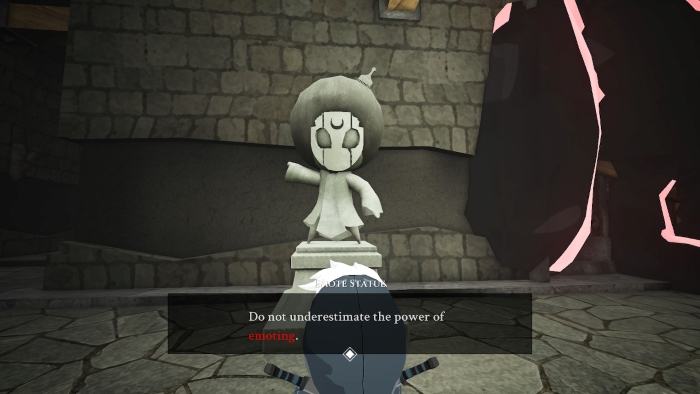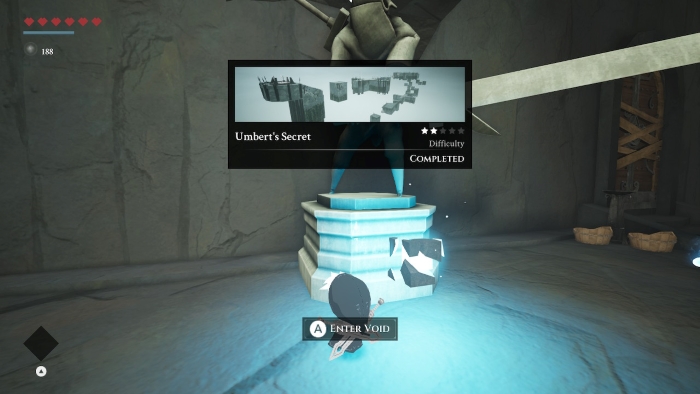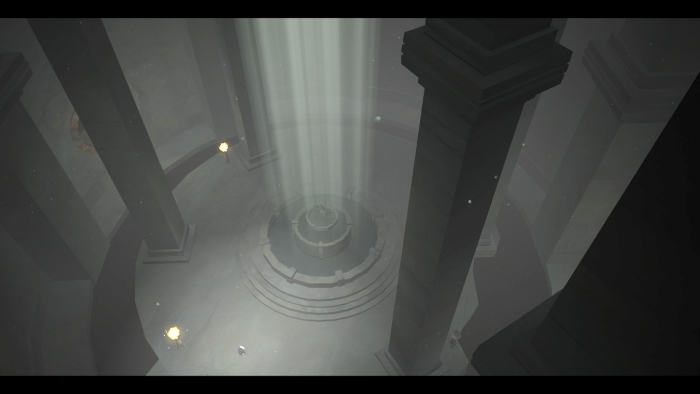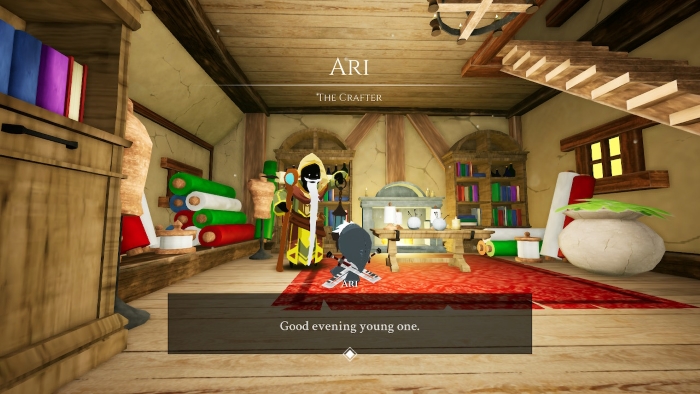
One night, The Legend of Zelda: Ocarina of Time, Celeste, and Hollow Knight all gathered together at the neighborhood soup kitchen to create a new recipe for the needy players of the community. After taking some time to finalize their new creation, they prepared the meal and set it out on the tables with the hungry players soon to arrive. After they finished setting the tables and returned to the kitchen, Dark Souls snuck in the side door. It quickly and quietly walked past all the place settings and sprinkled its special seasoning into the food so carefully prepared by the other games. This dungeon crawling, action-platformer features a tiny hero that’s sure to capture a few hearts.
Blue Fire opens in a dark room inside a place with the appearance of a castle. The player controls Umbra, a pint-sized warrior of mysterious origins. The first action you’ll take is mashing the attack button to break out of a glass or crystal enclosure within which Umbra is suspended. Looking around this area, named Fire Keep, quickly reveals that some sort of physical, corruptive force has taken over. Black and red forms weave their way in and out of the walls. They even cause damage when touched. Soon, Umbra discovers Von, the last of an order of warriors called Fire Guards. With a quick speech, he sets Umbra on his quest with very few details. Some of these details come from NPCs while more can be found from item descriptions.
Blue Fire is an action-adventure game, but at the core, Blue Fire is a 3D platformer. The majority of gameplay involves running, jumping, dashing, and scaling walls around the world to find secrets, earn power-ups, and journey to the stories’ end. Blue Fire also has enemies and bosses that are fought using a system strongly based on the style of early 3D Zelda games, such as Ocarina of Time. The game adds in all its platforming moves to create a unique flavor. For more hardcore platforming, there are platforming-specific challenges in the game called Voids.

Be sure to acquire all the emotes from the emote statues. Use your emotes to have fun and unlock secret treasures.
Robi Studios has placed a free strategy guide as a PDF download on the game’s official website for those who prefer to play with guides. With the guide in hand and a focus on completion, Blue Fire can take as few as 10 hours to complete. For players looking for the blind-playthrough experience, it can take twice as long. Challenge areas called Voids can be replayed infinitely.
Blue Fire is, first and foremost, a 3D platforming adventure. Umbra must jump, spin, and dash simply to reach point A from point B. There are no fields in Blue Fire; there is only architecture that must be maneuvered. Dungeon and dungeon-like areas of the world map add variety and challenge. Umbra doesn’t have many abilities in the beginning, but quickly acquires items that expand his possibilities. The ability to wall run is the first and early ability Umbra acquires, which also allows for wall jumping. Umbra can grab and vault off nearly every surface in Blue Fire, so much so that finding the few that can’t be grabbed proves a little disappointing. This allows for an impression of freedom rarely present in an indie title. There are treasure items that will grant innate abilities for the rest of the game, and there are also items called spirits.

Voids are platforming challenge courses that are set aside in separate instances in mystical spaces outside of the normal world.
The controls are accurate, precise, and snappy. It’s not just the function, but the ‘feel’ as well. The movement comes on demand—and stops on demand. For example, Umbra has a dash command, and that dash can be ended early by releasing the button. This is important to note as the dash ends the moment the button is released. This is a departure from many other platforming games where there tends to be some sliding after releasing buttons. This sort of super precision can a bit disconcerting, at first, as players may have an assumption that the character will drift a little while moving, jumping, and dashing around. Once players adjust to the movement and controls, moving about the game becomes immensely satisfying. The numerous spirits provide a great deal of relief later in the game. With the correct configuration of spirits, Umbra can nearly fly through some of the largest areas. A thrilling experience that elicits laughter from deep within one’s soul.

In Voids, Umbra gets a large stamina pool to do things like run along the surfaces of these columns, jumping between them to reach the goal.
However, the controls can be almost too perfect at times. There are a few areas where Umbra needs to use the wall cling and run ability to jump-climb between thin pillars. The controls are so accurate that a small, misdirected movement of the control stick can send Umbra too far to a side of a pillar and right back down to the floor. This can be annoying, at best, and frustrating at worst.
Spirits are additional abilities that Umbra can equip. Some of them will enhance his mobility, making some platforming challenges easier. Some of them will also enhance his combat abilities, providing more fighting options against enemies and bosses. There are only two slots for equipping these spirits, at the start, but several more can be added. Some spirits can be purchased, while others taunt the player from hard-to-reach places. Some spirits are hidden in unexpected places, while some are acquired through side quests.

Umbra meets the Spirit Hunter for the first time. He sells spirits and provides a reward when Umbra collects enough of them.
Voids are otherworldly challenges that are pure platforming courses. To complete a void, players must collect all items, called Void Souls, before reaching the end goal. Large statues of dual-wielding warriors are placed through the world of Penumbra. Some of them are on the common path, while others require varying degrees of platforming ability to reach. They each have a difficulty rating ranging from one star to five stars. While one and two stars are not difficult, the difficulty is more a measure of difficulty in relation to each other as opposed to an overarching standard. Voids are the only way to increase Umbra’s total health hearts. A benefit of voids is that there is largely increased stamina for wall running and climbing while it must normally be managed from a small amount. Players do not take damage from failure in Voids, so they can spend as little or as much time as they like attempting to complete these courses.

Umbra stands beside the statue of a former Fire Guard, one of many entrances to Voids, platforming challenge areas.
Blue Fire uses a very similar system of combat to that found in legacy 3D action titles—in particular, The Legend of Zelda: Ocarina of Time and its successors. There is a simple lock-on system that fixes on a single target from a fixed, over-the-shoulder point of view. Umbra only has one style of weapon and way of fighting, although there are several upgraded versions to find within the game world. Blue Fire adds its own flavor to the formula by allowing all modifications to movement that players can add through spirits or discovered treasure. Umbra can run and bounce off walls, escape off a platform edge only to jump back, and he can stay afloat above the enemy through various combinations of moves.
Umbra’s main weapon is a set of twin swords. In addition to his blades, he has an energy shield that can be used to parry attacks, and he has a chargeable ranged attack. Both abilities cost mana. The ranged attack is not very strong, but it does have its uses, and it scales with Umbra’s attack power as determined by his equipped swords. This keeps them in a useful state, especially when re-visiting earlier areas of the game.
The shield is extremely useful from the first moment of its use until the end of the game. Using the shield completely nullifies damage, and it can even perform a special parry deflection with the correct timing. Mana use is low, so the shield can be used frequently, but not indefinitely.
This is one area where Blue Fire suffers. There are a small number of enemy types. These types have slight variations throughout the various areas of the game both in appearance and attack type, or pattern. While the game showcases several impressively colossal areas, the journey through the game isn’t particularly colossal. As such, this issue can be put aside in exchange for the fun of hopping, jumping, climbing about the place looking for treasure and spirits, or trying to speed run the Void challenges.
Blue Fire does not showcase any stellar graphics. It uses a cell-animation style for the NPCs, enemies, and bosses, as well as the game’s protagonist. The settings are less charming and more functional, but they are sharp, clear, and colorful. The trade for lower graphics fidelity is nigh-perfectly smooth performance. There are a few areas where the game experiences some slow-down, but the majority of the game offers a smooth and fluid experience—perhaps its greatest strength and selling point. While the whole game map is not large, it contains shockingly massive rooms decorated with all manner of architecture, industrial piping, and other structures.

Umbra approaches a sacred fountain in an immense room, one of many that fill out the world of Penumbra.
Blue Fire has a few bugs large and small. Most of these only cause soft locks that can be resolved by using the game’s save system in which the game opens at the last save point even though progress can be saved anytime and anywhere. There are a few hard locks that will impede progress permanently. A patch has recently been released for Nintendo Switch that fixes all of the well-known issues, but players may need to start a new save file. For the players that have yet to play Blue Fire, rest assured the game is currently stable and playable. Players who may have put it down in frustration due to these issues in the past may want to return. However, remember to update to the latest version.
The music of Blue Fire does not contain any particularly complex tracks or broad orchestral symphonies. What it does offer are beautiful and soulful tunes of flutes, chimes, and drums. The tunes accompanying boss fights offer a little more intensity, but the journey through Penumbra is otherwise filled with ambient instrumental arrangements as a backdrop. This might seem like a negative characteristic, but it is quite the opposite. Nearly all traversal is either platforming-style movement or some type of traversal puzzle, and the ambient music perfectly complements the more deliberate movement and careful observation required of players as they explore the world for the first time.

Ari, The Crafter, sells cloaks of many colors and even provides of the lore the colors in the backdrop of Blue Fire.
Blue Fire is a labor of love with clear influences. The developers created a clear vision and followed through with that vision to recreate some of their favorite experiences. This effort is largely successful due to a focus on polished gameplay, an attractive protagonist, and a tightly controlled single-player experience. An experience that still allows some free exploration and a varied first-time experience. Above all, Blue Fire is fun to play. Although there are a few elements that could have fit in better, the gameplay experience does not suffer for it.
Blue Fire gets an 8/10.